
|
Sale 78
January Pre-Long Beach Sale 17.5% BP
| Lot |
Photo |
Description |
Realized |
Lot 1772 |
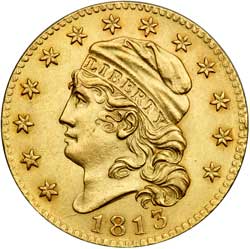 |
1813 BD-2 Rarity 4. PCGS graded MS-61. A decent strike with the usual softness on the Eagle's right wing. On a problem free planchet. Touches of delicate rose color toning rests within the devices. Always in demand for the first year of the new Capped Bust design. In 1813 John Reich modified his design of 1807-12. The portrait eliminates the bosom and drapery and there is now a head of Liberty exclusively; the stars were rearranged to completely encircle her, save for the date position, while other obverse and reverse details were altered.
From 1813 to 1829 half eagles were minted with a diameter of 25mm. Numismatists have been content to consider the span 1813-1834 as a single design although some split the issue into 1813-29 and 1829-34 (the latter having a plain raised border outside the denticles). For the entire date span 1813-1834 of these two types, business strike mintage is estimated as 1,385,612 coins. From time to time, Proofs were struck for special purposes, but mintage records of such pieces were not kept.
Of the half eagles minted from 1813 to 1829, probably no more than a thousand or two coins exist today, this being but a tiny fraction of the original mintage.
While many issues were minted in generous quantities during this era, today most varieties are exceedingly rare.
Soft muted luster with a few very minor abrasions and hairlines. The strike is strong generally, though a portion of the eagle indicates some weak flow into the die recesses, most noticeably at the center. This is the first year of the new Capped Head design type, an important opportunity for the Type collector. This design type continued, with slight modifications, through 1834, prior to introduction of the Classic Head design without reverse motto. This die variety is much scarcer than the other variety of this year, from a different reverse die. Dannreuther puts his estimate of survivors as 150 to 200 known (PCGS # 8116) .
Estimated Value $9,000 - 10,000.
The Del Valle Collection.
View details and enlarged photos
Check results on similar lots
| Realized
$14,100 |
Lot 1773 |
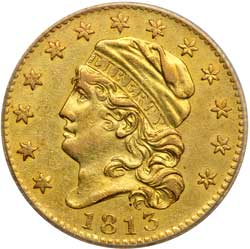 |
1813. ICG graded AU-50. BD-1. A hint of natural tone. Popular early type gold coins. Warm yellow golden color with traces of original mint bloom within the main devices (notable in Liberty�s hair curls for instance) and around the legends. Choice rims; the normal light circulation field marks though the coin we see is free from any heavy marks or injury, a definite plus. Historic, too, as the first year of a new design. John Reich refashioned these at the behest of Mint management. His signature chip out of one point on the 13th star is there to see. Production totaled 95,248 pieces, with BD-1 comprising the greater number according to Dannreuther (Rarity-2, 450 to 650 known).
The type set collector will have the best luck and the best use of his money if an issue such as 1813, 1814/3, 1818, or 1820 is selected, none of which will be inexpensive, but other issues are apt to be much more costly. The Half Eagle of the 1813-1829 design type is one of the highlights of a type set of early American gold coins.
Estimated Value $7,000 - 8,000.
View details and enlarged photos
| Realized
$6,340 |
Lot 1774 |
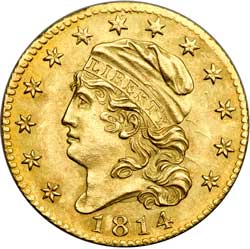 |
1814, 4 over 3 BD-1 Rarity 4+. NGC graded MS-61. Struck on a problem free planchet with faint clash marks as made. It is the frosty mint luster that grabs the attention of this popular type coin. Delicate golden hues further adds to the eye appeal. Substantial detail to the highpoints on this well struck example including the hair curls above Liberty�s ear and brow, those cascading along the neck, and other features of the portrait and most surrounding stars. A few stars at top are weak, as are the rim denticles along the same portion. Reverse is very crisply defined. The mostly warm honey-gold toning resides around the devices and displays modest, yet pleasing rising and falling luster effects as the viewer turns the coin under the light. There is a full accompaniment of frost throughout, including the key high points where surface friction first occurs.
The 1813-29 and the following (Kneass's Modified Capped Heads, 1829-34) are by far the most significant and difficult of all half-eagle designs to obtain. The reason is not low mintage, per se. Instead, it falls to extensive melting: a byproduct of the influx of silver from Mexican and Peruvian mines. This increase in the supply of silver on world markets compared with gold lowered the price of silver calculated in gold, the silver-to-gold ratio, emerging as an relentless rise in the value of gold reckoned in Mexican dollars. According to the Breen reference, "This is the reality behind the numerous statements about the world ratio rising from Alexander Hamilton's original 1791-92 estimate (15 to 1) to nearly 18 to 1. Its major side effects included hoarding and melting of "old tenor" gold coins when their bullion value exceeded their face value by enough to afford a profit over the cost of melting. In the National Archives is a reference to public assays (Paris, 1831), at one of which some 40,000 U.S. half eagles of "recent mintage" (the elusive 1815-30) were melted and found to be of full weight and fineness. This was doubtless only one among many such holocausts, and more were to come through 1837." Pop 11; 29 finer, 14 in 62, 7 in 63, 8 in 64 (PCGS # 8117) .
Estimated Value $15,000 - 17,000.
The Del Valle Collection.
View details and enlarged photos
Check results on similar lots
| Realized
$24,675 |
Lot 1775 |
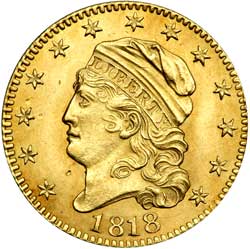 |
1818 PCGS graded Genuine Unc Details BD-1 Rarity 5. Scratch. The reverse side above the eagle shows some light scratches. Still a nice looking coin. Only 48,588 struck. A sharply struck specimen of this elusive date, not an extreme rarity and not in top condition, but seldom seen. Both obverse and reverse retain much luster, satiny, in light warm toned gold shades. The striking is fairly good, with just a few hints of lightness on Liberty�s lovelock; stars are full. The eagle shows minor detail diminishment near the juncture of the wing and the shield�s left edge, which is quite typical with this design. The eye appeal is of a high level for the modest grade, yielding a piece the admirer of early U.S. gold will appreciate.
On the reverse a die crack is seen from the bottoms of MERICA across the field to the D of the denomination. Struck from normal dies (on one variety, the inscription STATESOF could be viewed as a single word rather than two) and on another the 5D is over a mistaken 50.
This piece is a subset of the Capped Head to left style, stars surrounding, large diameter, minted from 1813-1827 -- a rather elusive design. Accordingly, perhaps a type set enthusiast will be the buyer (PCGS # 8119) .
Estimated Value $7,000-UP.
Ex: Purchased from Abner Kreisberg in the 1970's The Del Valle Collection.
View details and enlarged photos
Check results on similar lots
| Realized
$10,869 |
Lot 1776 |
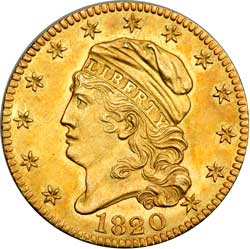 |
1820. Square Base 2 BD-2 Rarity 5+. PCGS graded MS-63. CAC Approved. A splendid needle sharp strike further enhanced by the frosty mint luster and sunset golden hues. A beauty! Highly lustrous choice fields with uniform satin texture and minimal surface marks. Under close inspection, the toning approaches the warm sunset shades found on the very finest such examples in museum collections, with luster the texture of the central motif is similarly fresh and robust, as made. As mentioned, this coin boldly struck with complete star centers on stars 1 through 13 without the least deviation in detail. Wide deep rim denticles on both sides provide beautiful framing for the inner design. The central devices are sharp on both sides, with Liberty's hair curls intricately defined, the crisp details also evident throughout the eagle's feathers, the stripes of the shield, legends, arrow points, and feathers, etc. Large letters reverse style with perfect Ts; a square base 2 in date. Pop 18; 15 finer, 11 in 64, 3 in 65, 1 in 66 (PCGS # 8125) .
The Year 1820: By 1820, the United States population had risen to 9,638,453; New York City's population, growing by leaps and bounds, numbered 123,000. Trade between the U.S. and England was again flourishing. Lord Liverpool told England's House of Lords that whoever wishes prosperity to England must also wish it to the U.S.
This was The Era of Good Feelings, marked by a period in the political history of the United States that reflected a sense of national purpose and a desire for unity among Americans in the aftermath of the Napoleonic Wars. The era saw the collapse of the Federalist Party and an end to the bitter partisan disputes between it and the dominant Democratic-Republican Party during the First Party System. President James Monroe endeavored to downplay partisan affiliation in making his nominations, with the ultimate goal of national unity and eliminating parties altogether from national politics. The period is so closely associated with Monroe's presidency (1817-25) and his administrative goals that his name and the era are virtually synonymous.
The designation of the period by historians as one of "good feelings" is often conveyed with irony or skepticism, since the history of the period is pockmarked with strained and divisive infighting, especially among factions within the Monroe administration and the Republican Party, along with the first true Depression in the U.S. following the Panic of 1819 that saw agricultural prices peak and then collapse almost overnight, bankrupting farmers and closing banks around the country.
Estimated Value $25,000 - 30,000.
Ex: Purchased from Abner Kreisberg in the 1970's The Del Valle Collection.
View details and enlarged photos
Check results on similar lots
| Realized
$49,350 |
Lot 1777 |
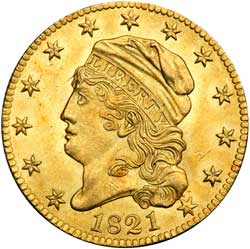 |
1821 BD-1 Rarity 6+. PCGS graded MS-63+. CAC Approved. A magnificent example, boldly struck on a problem free planchet and ablaze with intense mint luster. The shimmering surfaces are further enhanced by natural golden-olive overtones. This issue begins the trend of very rare Half Eagles, which continues throughout the decade. Interestingly, several die varieties exist for extremely low populations, suggesting that the recorded mintages are realistic, despite very low survival rates. Dannreuther & Bass describe two different varieties, this first having a close 13th star that is low and nearly touches Liberty�s curl, with widely spaced even date, and a second obverse in which star 13 is high and away from the curl, with 82 of date close, and both 1�s away from the bust and hair.
Very sharply struck with variegated warm golden color highlighting the surface. Throughout both sides the surface is quite clean with very few of the expected small marks noted. Such a pleasing specimen deserves to be flushed with pride at the good fortune to be from a source with such an illustrious provenance as the Amon Carter collection. When the golden heat of bidding is over and done with, the next owner may very well have his name appended to the provenance structure. This is one of the rarest dates in the entire Half Eagle series, although the mintage figure might indicate otherwise. PCGS has graded only one higher of this variety, a single MS-66!
The 1821 Half Eagle is, for some reason, among the more overlooked rarities from this period, eclipsed by the 1819 and 1825/4 issues. Dannreuther estimates there to be 12 to 15 around. A typical specimen grading just Extremely Fine is all that one usually sees offered for sale. The specimen offered here clearly rates high and is one of the choicer seen or offered for sale in many years.
The chief reason for the rarity of Half Eagles of this style lies not with any mintage figure, but, rather, with what happened to the coins after the left the mint and encountered the relationship of gold and silver prices in world markets. At the time, freshly minted gold coins, if melted, were worth more as bullion than face value. It is an interesting and perhaps numismatically oddity that after the War of 1812 ended (December 24, 1814; 1814 was the date of the peace treaty, but it effectively ended early in 1815), the Philadelphia Mint itself was paying a premium to buy its earlier-dated $5 gold coins! Somewhat similar to the situation that would occur years later with trade dollars, gold coins were produced only upon request from bullion depositors. Later issues never circulated at par. Many if not most were simply used as "trade" coins, later melted, or shipped overseas in payment for imports. To rectify this untenable situation and to permit gold coins to circulate at par in America, Congress lowered the authorized weight of gold coins through the Act of June 28, 1834, but not before virtually the entire production of Half Eagles of the early years passed into the hands of speculators and bullion dealers.
Although mintages were fairly generous for many dates from 1813 through 1829, nearly all of the issues in this span are great rarities today, this being especially true of the dates in the 1820s.
The type set buyer will have better luck and use of his money if an issue such as 1813, 1814/3, 1818, or 1820 is selected, none of which will be inexpensive, but other issues like the extremely rare 1821 presented here, are apt to be much more costly. The Half Eagle of the 1813-1829 design type is one of the highlights of a type set of early American gold coins. Pop 1; 1 finer in 66 (PCGS # 8129) .
Estimated Value $125,000-UP.
Ex: The Amon G. Carter Jr. Collection Jan. 18-21, 1984 Lot 659 The Del Valle Collection.
View details and enlarged photos
Check results on similar lots
| Realized
$540,500 |
Lot 1778 |
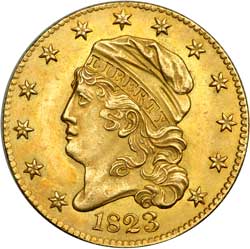 |
1823 BD-1 Rarity 4+. PCGS graded MS-63. CAC Approved. Well struck on a problem free planchet in greenish color gold. The lustrous surfaces exhibit natural mint bloom and hues of antique golden-rose overtones. Only 14,485 minted. A decidedly superior Liberty and eagle is the sharp blow from the dies leaving behind frostier high points than usual along with similar billowing mint frost in the field on this handsome gold coin. One of the few survivors after 95% to 97% of the original mintage was exported or melted. We note no signs of adjustment or carbon spotting, all is bright and fresh. A few scattered hairlines on both sides, always seen on the delicate lustrous surfaces. There are a couple of small marks, these will confirm the choice MS63 grade of this coin. Only a single die pair was used in 1823. The coins of this type, especially dates from 1820 to 1827, are considered rare. Locating even a low-end Mint State example can take years of persistent searching. An important coin that will no doubt feature high in any collection it graces. To quote the cataloguing expertise of Q. David Bowers during his landmark work on the Harry W. Bass, Jr. Collection, Part II, "on an absolute basis, very few 1823 half eagles exist, and no doubt a survey of leading dealers would reveal that many if not most have never handled even a single specimen in any grade." This particular piece carries appeal far surpassing the meager words we write about it. Pop 5; 7 finer, 1 in 63+, 5 in 64, 1 in 65 (PCGS # 8131) .
Historical note: On December 2, 1823, in his annual message to Congress, President James Monroe outlined a policy on foreign intervention. It wasn't until 30 years later that this document became known as the Monroe Doctrine. John Quincy Adams, then Secretary of State, is credited with having created this policy. An entry in his diary for November 7, 1823, tells of a meeting with John C. Calhoun and Samuel Southard on the subject of British proposals to join them in issuing a warning to the Holy Alliance (Russia, Austria, Spain, and France) against aggression in the Americas.
Estimated Value $35,000 - 40,000.
Ex: Purchased from Abner Kreisberg in the 1970's The Del Valle Collection.
View details and enlarged photos
Check results on similar lots
| Realized
$70,500 |
Lot 1779 |
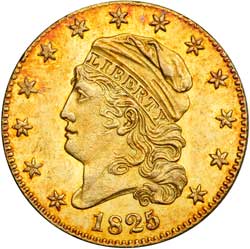 |
1825, 5 over 1 BD-1 Rarity 5+. PCGS graded MS-61. CAC Approved. The PCGS label shows "1825/4/1" on the holder. Mostly well struck and problem free with some light handling marks, none of which are worthy of mention. The lustrous surfaces exhibit prooflike reflectivity and tones to an extremely pleasing orange and rose color. According to renowned author David Akers, there are merely 35 to 40 examples of this date known to exist. However, the consensus today with numismatists is that Mr. Akers' estimated survival rate was slightly liberal and closer to 25 to 30 pieces are known to exist. Uncirculated examples of this rare date are seldom offered for sale. Considering the originality, eye appeal, and elusive nature, this coin would be an incredible addition to any serious collection.
According to the latest information on this variety from the Dannreuther guide on early U.S. gold, "Walter Breen speculated that the original digit below the 5 [on 1825 BD-1] might be a mostly effaced 4. The author has carefully examined the Bass example and others and believes that this theory is correct! It would be illogical to keep an 1821 obverse die for such a long time before using it. If it was an 1821 die, why was it not overdated in 1822, 1823, or 1824?"
Dannreuther goes on to report: "Comparison with the obvious 1825/4 overdate variety to follow (BD-2), the upright previously considered a 1 likely is a partially effaced 4. The part of the foot visible at the lower right of the 5 seems to be the foot of a 4. Another feature of this die that lends credence to this theory is the angle of the supposed 1. The angle of the original digit is exactly like the 4 on both the 1824 and 1825/4 obverse. It leans further left than the 1 on the 1821 die."
Having cleared up that conundrum, this is precisely the kind of attractive toned example that will interest a wide multiplicity of collectors from the hardened numismatist assembling a complete date series, to the more casual buyer looking for a nice rare date specimen from the 1820s to represent this Capped Head style (last used in 1827).
Most estimates peg the total number of survivors around 30. Akers described some decades ago some 10 offerings of Mint State coins over a 40 year period, and Breen accounted for 16 specimens known to him in 1966. The appearance of this rarity on the marketplace represents an excellent opportunity for the many cabinets which lack the 1825 date entirely. Pop 1; 4 finer, 2 in 63, 1 in 64, 1 in 65 (PCGS # 8133) .
Estimated Value $30,000 - 35,000.
Ex: Pine Tree's June 1975 Sale Lot 374 where it realized $8,500; believed to earlier have been in B. Max Mehl's Dunham 1941 Sale Lot 2098; Ex: Superior's Connoisseur's Collection Jan. 31, 1989 sale Lot 356 The Del Valle Collection.
View details and enlarged photos
Check results on similar lots
| Realized
$91,063 |
Lot 1780 |
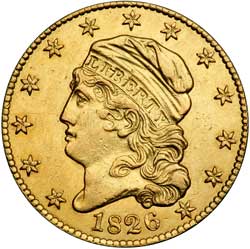 |
1826 PCGS graded Genuine AU Details BD-1 Rarity 5. Cleaning. A hint of gold tone and a nice looking coin. Light to moderate hairlines. Only 18,069 struck. Another of the rare dates in this decade, the most challenging series in all of U.S. numismatics. Claims that "most known examples are of the 1826 are Uncirculated, many of them gems," may be misplaced, but not completely untrue.
The strike on this coin are nothing short of bold. In fact, of all the devices show complete detail, down to the eagle�s wing and neck feathers and the lines in the shield. Weighing it down somewhat is the old-time cleaning, but the surfaces, other than for a random mark here and there (and one thin scratch above the eagle�s head, are mostly devoid of blemishes. Rare high quality overall and a coin with outstanding historical importance (PCGS # 8135) .
The Year 1826: In a letter to Madison in February 1826, five short months before the 6-foot-2 tall, red-headed ex Third President of the United Stated States died on July 4, Thomas Jefferson proposed selling some of his property through a lottery. Prior to the Revolution this was the practice, but fifty years on it required approval of the legislature. Jefferson's financial situation was precarious. In 1823 his debts totaled over $40,000, while his farms brought in a mere $10,000 yearly. Besides being the patriarch of a large clan, Jefferson entertained constantly at Monticello, and the cost of maintaining a county gentleman's life-style was becoming unsupportable.
Shortly after his letter to Madison, a lottery bill was passed, but by that time news of Jefferson's financial straits had spread throughout the country, and people began sending gifts of money to their former President. Over $16,000 was raised in the 3 cities of New York, Philadelphia, and Baltimore alone. Jefferson called this a pure and unsolicited offering of love, adding, "I have spent 3 times as much money and given my whole life to my countrymen and now they nobly come forward, in the only way they can, to repay me and save an old servant from being turned like a dog out of doors." Both he and John Adams, the 5 foot 4 inch tall Second President of the U.S., died on the same day, July 4, 1826, fifty years to the day after the signing of the Declaration of Independence, and only a few hours apart. (Neither man was aware of the other's passing.).
Estimated Value $7,000-UP.
Ex: Purchased from Abner Kreisberg as "Unc" in the 1970's The Del Valle Collection.
View details and enlarged photos
Check results on similar lots
| Realized
$8,225 |
Lot 1781 |
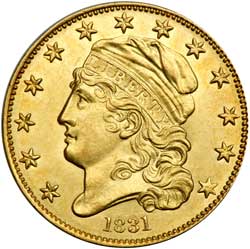 |
1831 BD-2 Rarity 6. PCGS graded MS-62. CAC Approved. A boldly struck example of the "Fat Head" reduced size Capped Head type. The intensely lustrous surfaces are prooflike and remarkably clean of marks. The natural greenish-golden color adds to its appeal.The $5 Half Eagle was modified in 1829 by mint engraver William Kneass. All of the coins from the short-lived Kneass design until 1834 are very rare. This design originated with John Reich's Capped Bust Left design which was one of his first major coinage revisions upon joining the Philadelphia Mint in 1807. Liberty's head was again modified in 1813, with dies engraved by John Reich (1813-1815). This short-lived group again show his usual notched star "signature" on the lowermost star right of the date. Reich resigned in 1817. Engraver Robert Scot reworked the obverse device punch of Liberty, but the result was not as skillfully rendered. Liberty's cap on the post-1815 issues has more wrinkling, and the hair is coarser. The Scot design continued in use until 1829 when William Kneass once again reconfigured the central device, giving Liberty a more finished and graceful appearance. The new Kneass design was issued from 1829 until 1834.
During the years from 1813 to 1834 the price of gold bullion, as we have explained earlier, exceeded the face value of America�s gold coins. Widespread melting took place as speculators arbitraged the price disparity.
This is a pleasing prooflike example is the only one in its PCGS grade category. Dannreuther suggests 22 to 30 are known of 1831 BD-2. We would be surprised to learn that even as many as 30 examples of this variety are known in all grades. Pop 1; 4 finer, 1 in 63, 1 in 64, 1 in 65, 1 in 67 (PCGS # 8153) .
1831 is the year the term "Old Glory" was said to have been coined by New England seaman William Driver. Before setting sail for Asia, he saluted the flag as it was unfurled, saying: "I name thee Old Glory!" The term was not popularized until the Union troops used it in the Civil War. The year 1831 also recorded the first bank heist in the U.S. The City Bank of New York was opened with a duplicate set of keys and robbed of $245,000, an immense sum in those days. Edward Smith was later convicted and sentenced to 5 years at Sing Sing.
Estimated Value $60,000 - 70,000.
Ex: Purchased from Abner Kreisberg in the 1970's The Del Valle Collection.
View details and enlarged photos
Check results on similar lots
| Realized
$152,750 |
Lot 1782 |
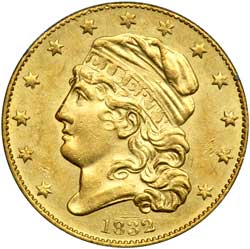 |
1832. Square Base 2, 13 stars BD-1 Rarity 5. PCGS graded AU-58. Housed in a First Generation Holder. Well struck in natural greenish color gold, lustrous with some scattered light handling marks, all lightly toned. A choice high grade example of this popular and rare type coin. The 13 Stars BD-1 variety, while not as rare as the 12 Stars BD-2 of 1832, is nevertheless a very elusive coin -- Breen estimated 14 to 18 known from his experience, Dannreuther has since upped the estimate to 40 to 50 known (Rarity-5) out of 157,487 struck for the year. According to Dannreuther: There are as many as 50 examples surviving. This may seem high to some specialists, but quite a few of these coins have been brought to market because of higher prices in the past 25 years. This is still not a common coin, of course, and all Fat Head Fives are popular and snapped up by savvy collectors at auctions and on the bourse floor. For some reason, half eagles of the 1830s are often seen with extensive evidence of handling, unlike most of the dates in the 1820s." Pop 2; 11 finer, 1 in 61, 4 in 62, 3 in 63, 3 in 64 (PCGS # 8156) .
Until 1833, three buildings provided America with hard money. Operations moved to the Second Philadelphia Mint in 1833 and the land housing the first mint was sold. In the late 19th or early 20th century, the property was sold to Frank Stewart, who approached the city asking them to preserve or relocate the historic buildings. With no governmental help "Ye Olde Mint" was demolished between 1907 and 1911. A small plaque now marks the only spot memorializing the first mint.
This 1832 Half Eagle was one of the last made at the First Philadelphia Mint which charmingly had the date and words "1792 Ye Olde Mint" painted on its street side wall above the second floor windows. On July 4, 1829, a cornerstone was laid at the intersection of Walnut and Juniper Sts. for its replacement. It was designed by William Strickland. The second Philadelphia Mint, the "Grecian Temple", was constructed of white marble with classic Greek style columns on front and back was under construction at the time the mint struck this 1832 $5 gold piece. Measuring 150 feet wide in front by 204 feet deep, it was a huge improvement over the first facility, in space as well as image. Opening in January 1833, its production was constrained by the outdated machinery salvaged from "Ye Olde Mint". Director of the Mint Franklin Peale was sent to Europe to study advanced coin making technologies which were brought back and implemented, increasing productivity and quality.
Estimated Value $40,000 - 45,000.
Ex: Purchased from Superior in the late 1980's The Del Valle Collection.
View details and enlarged photos
Check results on similar lots
| Realized
$85,188 |
|
|